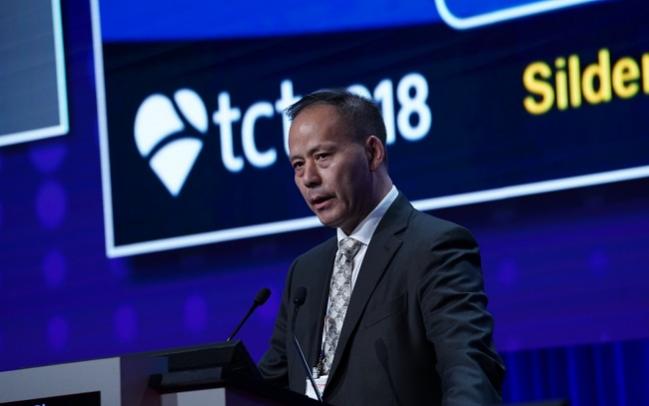Denervation Has Possible Benefit for Pulmonary Hypertension Related to Left Heart Failure
PADN-5 shows that pulmonary artery denervation can be done safely, but study limitations hinder the assessment of clinical impact.

SAN DIEGO, CA—Pulmonary artery denervation led to clinical improvements in patients with pre- and postcapillary pulmonary hypertension associated with left heart failure in the randomized PADN-5 study, but the results were not seen as definitive in light of trial limitations.
Compared with patients who underwent a sham procedure and were treated with sildenafil, those who received denervation had a significantly larger increase in 6-minute walk distance through 6 months of follow-up (21.4% vs 4.9%; P < 0.001), Shao-Liang Chen, MD (Nanjing Medical University, China), reported here at TCT 2018.
Denervation also was associated with improvements in hemodynamic and echocardiographic parameters and a lower rate of clinical worsening (16.7% vs 40.0%; P = 0.018).
“The PADN-5 trial demonstrates the benefit of pulmonary artery denervation in [these patients],” Chen concluded, noting that effects were comparable in patients with preserved or with reduced ejection fraction.
But the results—published simultaneously online in JACC: Cardiovascular Interventions—do not prove that denervation is safe and effective, according to Ori Ben-Yehuda, MD (Cardiovascular Research Foundation, New York, NY), who moderated a press conference at which they were presented.
The main limitation of the trial, he told TCTMD, was the use of open-label sildenafil in the sham arm, which effectively unblinded those patients. In addition, sildenafil might have had an impact on clinical outcomes, muddying interpretation of the effects of denervation.
Though PADN-5 is unique in that it is relatively large, it is the first randomized trial to evaluate pulmonary denervation in patients with left heart failure, and it is at least partially sham-controlled, more rigorously conducted studies with true sham controls are needed to establish the utility of the approach, Ben-Yehuda said.
“It shows that it can be done safely. It shows that there may be a signal for benefit. But it is far from definitive,” he said, noting that there are additional feasibility studies of both radiofrequency and ultrasound denervation ongoing.
During his presentation, Chen explained that backward transmission of increase LV filling pressure pushes up pulmonary venous pressure, which can eventually lead to combined pre- and postcapillary pulmonary hypertension. Medications for World Health Organization (WHO) group 1 pulmonary arterial hypertension (PAH) are not recommended in patients with this condition, he noted.
A prior study showed that pulmonary artery denervation improved hemodynamic parameters in patients with PAH of various etiologies, so Chen and colleagues set out to evaluate denervation in patients with pre- and postcapillary pulmonary hypertension associated with left heart failure.
The PADN-5 Study
PADN-5, conducted at four centers, included 98 patients who had recently been admitted for worsening heart failure and then stabilized. All had mean pulmonary arterial pressures of at least 25 mm Hg, pulmonary capillary wedge pressures greater than 15 mm Hg, and pulmonary vascular resistance greater than 3.0 Wood units. Patients in the control group underwent a sham denervation procedure and received sildenafil at a dose of 20 mg tid for 1 week followed by 40 mg tid for 6 months. Patients in both arms received standard medical therapy for heart failure.
Overall, 39% of patients had a preserved ejection fraction (50% or higher). The duration of pulmonary hypertension ranged from 0.3 to 9.8 years.
All echocardiographic and hemodynamic parameters improved to a greater extent in the denervation arm over 6 months of follow-up, with the exception of right arterial pressure, which did not change. Of note, pulmonary vascular resistance, a secondary endpoint, was lower at 6 months in the denervation group (4.2 vs 6.1 Wood units; P = 0.001).
The primary endpoint was 6-minute walk distance, which increased by an average of 83 m in the denervation arm and by 15 m in the control arm (P < 0.001). The proportion of patients with a decrease in walk distance, which was associated with overall clinical worsening, was higher in the sham-control group (26.7% vs 12.5%).
The main safety endpoint was suspected/fatal pulmonary embolism; there was one case in each group during the study.
Even though limitations of the study prevent the drawing of firm conclusions, “there is a very solid biologic, scientific rationale for doing pulmonary denervation,” Ben-Yehuda said. He explained that there is a large body of evidence showing that sympathetic activity is increased in patients with pulmonary hypertension. In addition, preclinical data show that ablating the sympathetic nerves in the main pulmonary arteries can reduce pulmonary pressures.
“Whether this therapy will be disease-modifying remains to be seen, but it is a promising therapy,” Ben-Yehuda said.
Note: Ben-Yehuda is a faculty member of the Cardiovascular Research Foundation, the publisher of TCTMD.
Todd Neale is the Associate News Editor for TCTMD and a Senior Medical Journalist. He got his start in journalism at …
Read Full BioSources
Zhang H, Zhang J, Chen M, et al. [Pulmonary artery denervation significantly increases 6-minute walk distance for patients with combined pre- and post-capillary pulmonary hypertension associated with the left heart failure: PADN-5 study.](Zhang H, Zhang J, Chen M, et al. Pulmonary artery denervation significantly increases 6-minute walk distance for patients with combined pre- and post-capillary pulmonary hypertension associated with the left heart failure: PADN-5 study. J Am Coll Cardiol Intv. 2018;Epub ahead of print.) J Am Coll Cardiol Intv. 2018;Epub ahead of print.
Disclosures
- The study was funded by grants from the Nanjing Health Bureau and the National Science Foundation of China.
- Chen reports being the inventor on, but not the owner of, patents for pulmonary artery denervation.
- Ben-Yehuda reports no relevant conflicts of interest.


Comments